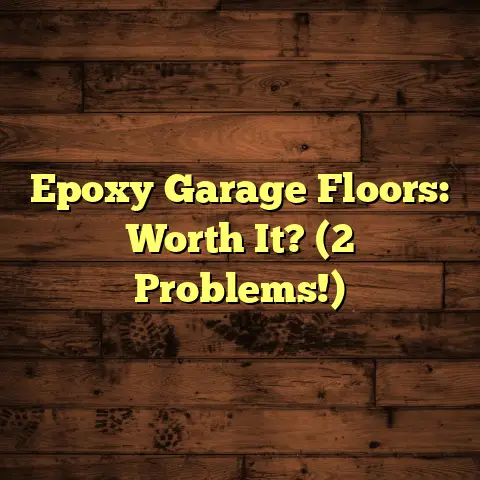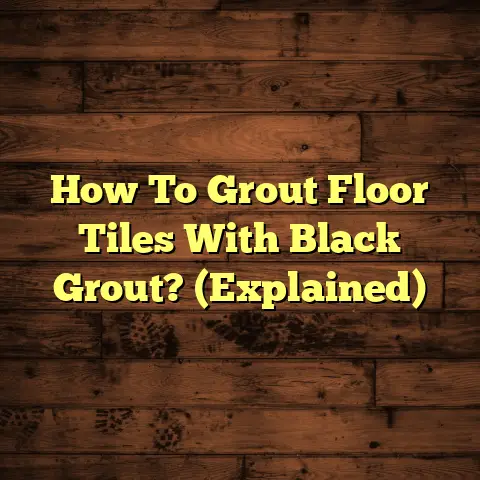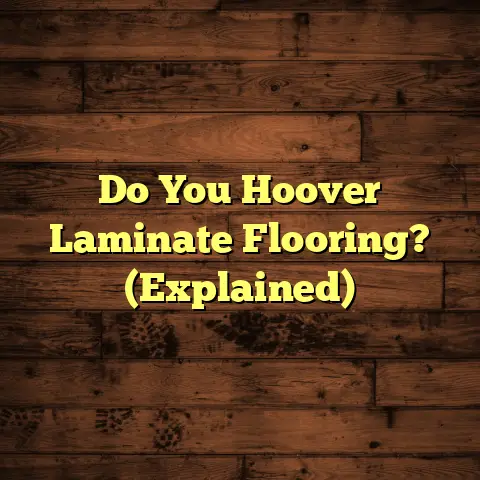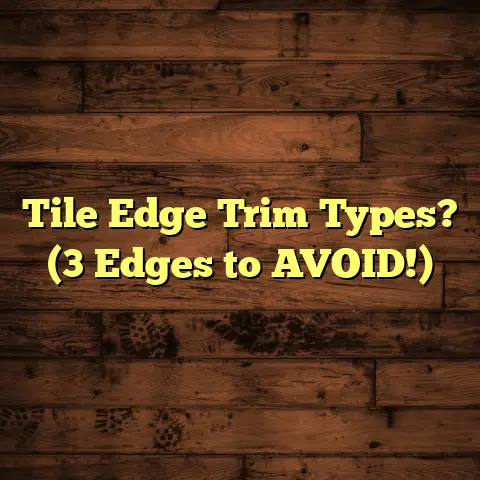12 Mil Vinyl Flooring: Good Choice? (1 Reason To Doubt)
Ever find yourself lost in the labyrinth of flooring options, wondering if you’re making the right call? I get it.
As a flooring contractor for over 15 years, I’ve seen it all – from hardwood dreams turned nightmare to laminate that just won’t quit.
Today, let’s dive into the world of 12 Mil vinyl flooring.
You’ve probably heard the buzz: affordable, stylish, easy to install.
But is it really all it’s cracked up to be?
Let’s break it down.
Vinyl flooring, in general, has become a powerhouse in the flooring industry.
Its resilience, design versatility, and cost-effectiveness make it a top choice for many homeowners.
We’re talking about a synthetic flooring material made from polyvinyl chloride (PVC) and other compounds.
That “12 Mil” part? That refers to the thickness of the wear layer, the top protective layer that determines how well your floor resists scratches, dents, and stains.
Now, the purpose of this article is simple: to give you the straight facts about 12 Mil vinyl flooring.
We’ll explore its benefits, sure, but we’re also going to tackle the elephant in the room: one significant reason why you might want to think twice before committing.
Ready? Let’s get started.
Section 1: Durability Myths
Subsection 1.1: Common Misconceptions
Alright, let’s bust some myths.
I’ve heard it all, and I’m sure you have too.
“Vinyl flooring is impervious to damage!”
“It’s scratch-proof!”
“All vinyl floors are created equal!”
Hold on a second.
While vinyl flooring is durable, these statements are simply not true.
Think of it like this: even Superman has his kryptonite.
Vinyl flooring, including the 12 Mil variety, has its weaknesses.
One common misconception is that the “Mil” thickness is the only factor determining durability.
While it’s important, it’s not the whole story.
The quality of the vinyl, the manufacturing process, and even the underlayment used all play a role.
I’ve seen 12 Mil vinyl floors that look fantastic after years of use, and others that are scratched and faded within months.
It all comes down to the specifics.
Subsection 1.2: The Reality of Wear and Tear
So, what does affect the durability of 12 Mil vinyl flooring?
A lot, actually.
-
Foot Traffic: This is a big one. The more people (and pets!) walking on your floor, the faster it will wear down.
-
Installation Quality: A poorly installed vinyl floor is a disaster waiting to happen. Gaps, uneven surfaces, and improper adhesives can all lead to premature wear and tear.
-
Environmental Conditions: Sunlight, humidity, and temperature fluctuations can all impact the lifespan of your vinyl floor.
-
Maintenance: Neglecting your vinyl floor can shorten its lifespan. Regular cleaning and the use of protective mats can make a big difference.
Let me give you a real-world example.
I once installed a beautiful 12 Mil vinyl floor in a sunroom.
The homeowner loved it!
But within a year, the area near the large windows started to fade and become brittle.
Why? Constant exposure to direct sunlight.
The lesson here is that even the best vinyl flooring isn’t invincible.
It requires proper care and consideration of its environment.
Subsection 1.3: Comparison with Other Flooring Types
How does 12 Mil vinyl stack up against other flooring options?
Let’s take a look:
-
Laminate: Laminate is generally more scratch-resistant than 12 Mil vinyl, but it’s also more susceptible to water damage.
-
Hardwood: Hardwood is beautiful and durable, but it’s also expensive and requires more maintenance than vinyl.
-
Tile: Tile is incredibly durable and water-resistant, but it can be cold and hard underfoot.
Here’s a quick comparison table:
| Flooring Type | Durability | Cost | Maintenance | Water Resistance |
|---|---|---|---|---|
| 12 Mil Vinyl | Moderate | Low | Low | Moderate |
| Laminate | High | Mid | Low | Low |
| Hardwood | High | High | High | Low |
| Tile | Very High | Mid | Low | Very High |
The key takeaway?
Every flooring type has its pros and cons.
While 12 Mil vinyl offers a good balance of affordability and durability, it’s not the most durable option out there.
I remember one client who insisted on installing 12 Mil vinyl in their high-traffic entryway.
I advised against it, but they were set on the look and price.
Within two years, the floor was showing significant wear and tear.
They ended up replacing it with tile.
Sometimes, the cheapest option in the short term ends up costing you more in the long run.
Section 2: Pros of 12 Mil Vinyl Flooring
Okay, enough doom and gloom.
Let’s talk about the good stuff.
12 Mil vinyl flooring has a lot to offer, and that’s why it’s so popular.
Subsection 2.1: Cost-Effectiveness
This is a big one for many homeowners.
12 Mil vinyl is significantly cheaper than hardwood, tile, or even high-end laminate.
According to recent estimates, you can expect to pay anywhere from $2 to $5 per square foot for 12 Mil vinyl flooring, installed.
Compare that to $8 to $15 per square foot for hardwood, and you can see why it’s an attractive option for budget-conscious homeowners.
The savings don’t stop there.
Because vinyl is relatively easy to install, you can save money on labor costs by doing it yourself.
Of course, I always recommend professional installation for the best results, but DIY is definitely an option for those who are handy.
Subsection 2.2: Aesthetic Appeal
Vinyl flooring has come a long way in recent years.
Gone are the days of limited designs and cheesy patterns.
Today, you can find 12 Mil vinyl that mimics the look of hardwood, tile, and even stone.
The possibilities are endless.
You can choose from a wide variety of colors, textures, and patterns to create the perfect look for your home.
Want a rustic farmhouse vibe?
There’s vinyl flooring for that.
Prefer a sleek, modern aesthetic?
You can find vinyl that fits the bill.
One of the things I love about vinyl is its versatility.
It can be used in any room of the house, from the kitchen to the bathroom to the bedroom.
And because it’s water-resistant, it’s a great option for areas that are prone to moisture.
Subsection 2.3: Ease of Installation
As I mentioned earlier, vinyl flooring is relatively easy to install, especially compared to other flooring types.
Most 12 Mil vinyl flooring comes in either planks or tiles, which can be installed using a variety of methods:
-
Glue-Down: This method involves applying adhesive to the subfloor and then pressing the vinyl planks or tiles into place. It’s a more permanent solution that’s best left to the professionals.
-
Click-Lock: This method uses a tongue-and-groove system to connect the planks or tiles together. It’s a floating floor, which means it’s not directly attached to the subfloor. This is a popular option for DIYers.
-
Peel-and-Stick: This method involves removing a backing from the vinyl planks or tiles and then sticking them to the subfloor. It’s the easiest method, but it’s also the least durable.
If you’re a DIY enthusiast, you can definitely tackle a click-lock vinyl installation.
Just be sure to do your research, follow the instructions carefully, and take your time.
A properly installed vinyl floor can last for years, while a poorly installed one will be a constant source of frustration.
Section 3: The One Reason to Doubt
Okay, here it is: the reason why you might want to think twice about 12 Mil vinyl flooring.
Subsection 3.1: Vulnerability to Specific Conditions
While 12 Mil vinyl is water-resistant, it’s not waterproof.
And that’s a crucial distinction.
Prolonged exposure to moisture can cause serious problems, such as:
-
Warping: The vinyl planks or tiles can start to warp and buckle, creating an uneven surface.
-
Bubbling: Moisture can get trapped underneath the vinyl, causing it to bubble up.
-
Mold Growth: In severe cases, mold can grow underneath the vinyl, creating a health hazard.
The biggest culprit?
Humidity.
High humidity levels can wreak havoc on vinyl flooring, especially in areas like bathrooms, basements, and kitchens.
I’ve seen countless cases where 12 Mil vinyl flooring has failed prematurely due to moisture issues.
One example that sticks out in my mind is a basement renovation I did a few years ago.
The homeowner installed 12 Mil vinyl flooring throughout the basement, including the bathroom.
Within a year, the vinyl in the bathroom started to warp and bubble.
The problem?
The basement had high humidity levels, and the vinyl wasn’t able to withstand the constant moisture.
Subsection 3.2: Long-Term Viability Concerns
So, what does this mean for the long-term viability of 12 Mil vinyl flooring?
It means that you need to be realistic about its limitations.
If you live in an area with high humidity, or if you’re planning to install vinyl in a moisture-prone area, you need to take extra precautions.
This might involve:
-
Installing a vapor barrier: This will help to prevent moisture from seeping up from the subfloor.
-
Using a dehumidifier: This will help to keep humidity levels in check.
-
Choosing a higher-quality vinyl: Some vinyl floors are more water-resistant than others.
-
Ensuring proper ventilation: This will help to prevent moisture from building up.
But even with these precautions, there’s no guarantee that your 12 Mil vinyl floor will last forever.
According to industry data, the average lifespan of vinyl flooring is 10-20 years.
However, that lifespan can be significantly shorter if the floor is exposed to excessive moisture or humidity.
I’ve seen 12 Mil vinyl floors that have lasted for 20 years with proper care, and others that have failed within just a few years.
It all depends on the specific conditions.
Conclusion
So, is 12 Mil vinyl flooring a good choice?
The answer, as always, is it depends.
It’s a cost-effective, stylish, and relatively easy-to-install option that can be a great fit for many homes.
But it’s not without its limitations.
Its vulnerability to moisture and humidity is a significant concern, especially in certain environments.
Before you commit to 12 Mil vinyl, take a close look at your specific needs and conditions.
Consider the humidity levels in your home, the amount of foot traffic your floor will receive, and your budget.
And don’t be afraid to consult with a flooring professional to get their expert opinion.
Ultimately, the best flooring choice is the one that meets your needs, fits your budget, and will stand the test of time.
I’ll leave you with this thought:
Choosing the right flooring is an investment in your home and your future.
Don’t rush the decision.
Do your research, weigh your options, and make an informed choice that you’ll be happy with for years to come.





